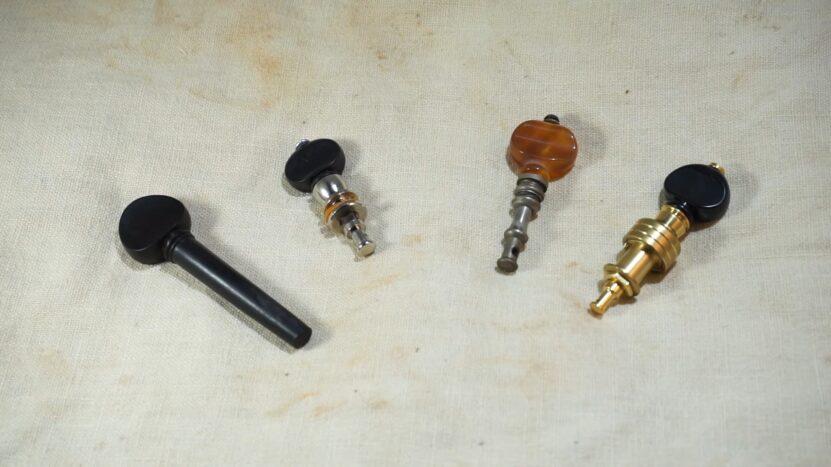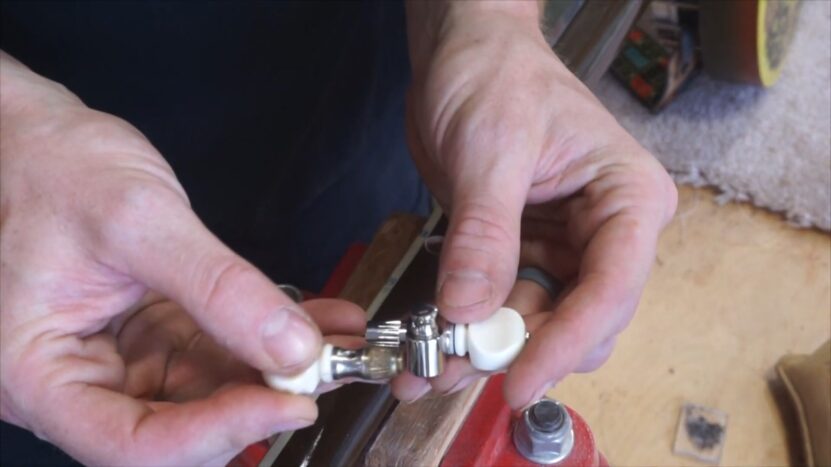Musical innovation isn’t just about genre-bending compositions or deft finger-work on the fretboard. Sometimes, it’s about tweaking the instrument itself to unlock unique tonal qualities. Welcome to the fascinating world of using banjo tuners on guitars. It’s an unconventional approach that promises to challenge your ideas about what a guitar can sound like, expanding your musical boundaries and enriching your playing experience.
For many guitarists, especially those accustomed to traditional tuning pegs, the concept of using banjo tuners might seem alien, if not slightly intimidating. But fear not. This comprehensive guide will demystify the process and delve into the mechanics, benefits, and potential drawbacks of using banjo tuners on your guitar. By exploring this less-trodden path, you’ll be joining the ranks of musicians willing to think outside the box in search of that elusive, perfect tone.
An Overview of the Mechanics and Functionality of Banjo Tuners

Banjo tuners are, as the name suggests, typically used to adjust the string tension on banjos. They differ from conventional guitar ones in both their design and operation. Primarily, they come in three varieties: peg, geared, and planetary tuners. Each of these tuner types operates differently to adjust the pitch of the strings.
Peg tuners, also known as friction pegs, function similarly to the tuning pegs on a violin. They require careful adjustment, as the tension holding the string in tune comes from the friction of the peg in the hole. Geared tuners, on the other hand, use a gear system that provides a mechanical advantage, allowing for precise tuning. The most technologically advanced of the three planetary tuners employs an internal network of gears to achieve the desired tension and pitch.
Understanding the functionality of each type of tuner is crucial before you embark on the process of using banjo tuners on your guitar. It’s also essential to realize that banjo tuners can offer greater tuning stability and allow for rapid string retuning – a plus for guitarists looking to experiment with their sound or regularly switch between different tunings.
The Benefits of Using Banjo Tuners on Guitars

When it comes to benefits, using banjo tuners on guitars offers a myriad of advantages that can transform your guitar-playing experience. First and foremost, they provide an expanded tonal range thanks to the swift return possibilities they offer. This is particularly beneficial for guitarists who frequently play in open or alternate tunings.
Moreover, the physical design of banjo tuners can result in a unique aesthetic for your guitar, setting it apart from the crowd. For musicians who pride themselves on their individuality, this customization can be an added bonus. It’s not just about looks, though. The use of banjo tuners can lead to a more balanced tension across the strings, resulting in improved playability and a smoother, more consistent sound.
Finally, for those in pursuit of the perfect sound, the precision offered by geared and planetary banjo tuners can provide superior control over pitch adjustment. The increased tuning stability can make all the difference in live performances, where environmental conditions and vigorous strumming can take a toll on your guitar’s tuning.
Installing Banjo Tuners on Your Guitar: Step-by-Step Guide
Before starting the installation process, make sure you have the necessary tools: a screwdriver, a drill (optional), and your chosen set of banjo tuners. Remember, patience and accuracy are your best friends during this procedure. If you’re not comfortable with the process, it’s advisable to seek professional help.
Start by loosening the strings on your guitar and removing the existing tuners. This typically involves unscrewing them from the back of the guitar’s headstock. Next, position your banjo tuners in the vacant holes. Depending on the fit, you might need to expand the existing holes slightly using a drill.
Once the tuners are in place, secure them by screwing them into the headstock. Take care not to overtighten the screws, as this can cause damage. Re-string your guitar as you would normally, taking advantage of the banjo tuners to adjust the tension and pitch. It may take some time to get accustomed to the new feel of your instrument, but with practice, the process will become second nature.
Peg, Geared, and Planetary Types

As mentioned earlier, banjo tuners come in three main types: peg, geared, and planetary. Peg ones are the most basic of the three and are typically found on older or more traditional instruments. They’re simple and effective but require a bit more finesse to keep in tune due to their reliance on friction.
Geared ones offer a step up in precision and stability. They use a worm gear mechanism that allows for more precise pitch adjustments and improved tuning stability. This is particularly useful for guitarists who use alternative tunings or play in environments where the guitar’s tuning might be susceptible to changes in temperature and humidity.
Planetary tuners are the most advanced and sophisticated of the three. Using an internal gear system, they enable the smoothest and most precise tuning adjustments of all. They are perfect for the guitarist who wants the best control over their instrument’s pitch and the highest level of tuning stability.
Pros and Cons of Using Banjo Tuners on Guitars
While banjo tuners offer several benefits for guitarists, it’s also important to consider the potential downsides. One of the main advantages, as previously mentioned, is the rapid and smooth retuning. This advantage is a boon for those who often use alternate tunings or like to experiment with their sound. Additionally, the unique aesthetic that banjo tuners bring to a guitar can be appealing to many.
However, there are also potential drawbacks to bear in mind. Installing banjo tuners on a guitar can be a challenging process, especially for beginners. This procedure may require some drilling into the guitar’s headstock, which could potentially devalue the instrument if not done properly. Also, some may find the look of banjo tuners on a guitar off-putting, as it deviates from the traditional appearance.
Furthermore, while banjo tuners can offer greater tuning stability, they may also demand more frequent adjustment and maintenance than standard guitar tuners. Particularly peg tuners can be more sensitive to temperature and humidity changes, necessitating regular checks and adjustments to keep the guitar in tune.
How to Achieve Optimal Performance
Achieving optimal performance with banjo tuners on a guitar largely comes down to proper installation and regular maintenance. As highlighted earlier, the installation process should be approached with patience and precision, and if you’re unsure, don’t hesitate to seek professional help.
Once installed, regular tuning is essential to maintain the best performance. Given the different mechanisms, you’ll need to get used to the feel and response of your new tuners. Spend time experimenting with them and understanding their nuances.
Moreover, try to keep your guitar in a stable environment to minimize the impact of temperature and humidity changes. Regular cleaning and maintenance of your tuners are also vital to keep them functioning optimally. This includes occasionally lubricating the gears, especially in the case of geared and planetary tuners.
Care and Cleaning Tips
Banjo tuners require regular care and cleaning to keep them functioning optimally. Start by regularly wiping them down with a soft, dry cloth to remove any dust or grime. Avoid using harsh chemicals or abrasives that could damage the tuner’s finish or mechanisms.
For geared and planetary tuners, occasional lubrication is necessary. Use a high-quality instrument lubricant, applying sparingly to the tuner’s gears. Be sure to wipe away any excess lubricant to prevent it from attracting dust.
Finally, if you notice any issues with your tuners, such as difficulty in turning or a slipping tuner, it’s advisable to seek professional help. Attempting to repair a malfunctioning tuner without proper knowledge can lead to further damage.
Popular Brands and Models of Banjo Tuners for Guitars
There are several brands and models of banjo tuners that are popular among guitarists. Gotoh and Grover are two such names that consistently receive high praise for their quality and reliability. The Gotoh GB350 Res-o-lite ones are a popular choice for their lightweight design and precise tuning. Meanwhile, Grover’s Champion Sta-Tite ones are known for their vintage aesthetic and sturdy construction.
For those seeking a more high-end option, Schaller’s GrandTune tuners offer an unparalleled combination of traditional design and modern technology, resulting in excellent tuning stability and ease of use.
When selecting a set of banjo tuners for your guitar, remember that your choice should align with your personal preferences and the specific requirements of your instrument. Factors such as the size, the ratio of the gears, and the style are all important considerations.
Famous Guitarists Who Use Banjo Tuners
Several high-profile guitarists have used banjo tuners to add a unique touch to their sound. Jimmy Page of Led Zeppelin famously used banjo tuners on his Gibson EDS-1275 double-neck guitar during performances of “Stairway to Heaven.” The ability to rapidly switch tunings between songs was a key part of Page’s dynamic live performances.
Jonny Greenwood of Radiohead is another notable guitarist who has used banjo tuners. Greenwood frequently uses alternate tunings in his compositions, and banjo tuners allow him to switch tunings swiftly during performances.
These are just a couple of examples of famous guitarists who’ve made the unconventional choice to use banjo tuners. They serve as inspiring examples of musicians willing to push boundaries and seek out innovative ways to enhance their sound.
Final Words
Using banjo tuners on a guitar is not a new idea, but it’s one that remains somewhat on the fringes of mainstream guitar playing. Yet, as we’ve seen, this approach can offer significant benefits in terms of tone, tuning stability, and the ability to rapidly switch between tunings.
In the end, the choice to use banjo tuners is a deeply personal one. It’s a decision that should be based on your playing style, musical preferences, and willingness to explore new sonic territories. Whether you’re a seasoned professional or an amateur enthusiast, the journey of exploring banjo tuners on guitars promises to be a rewarding adventure of musical discovery.

